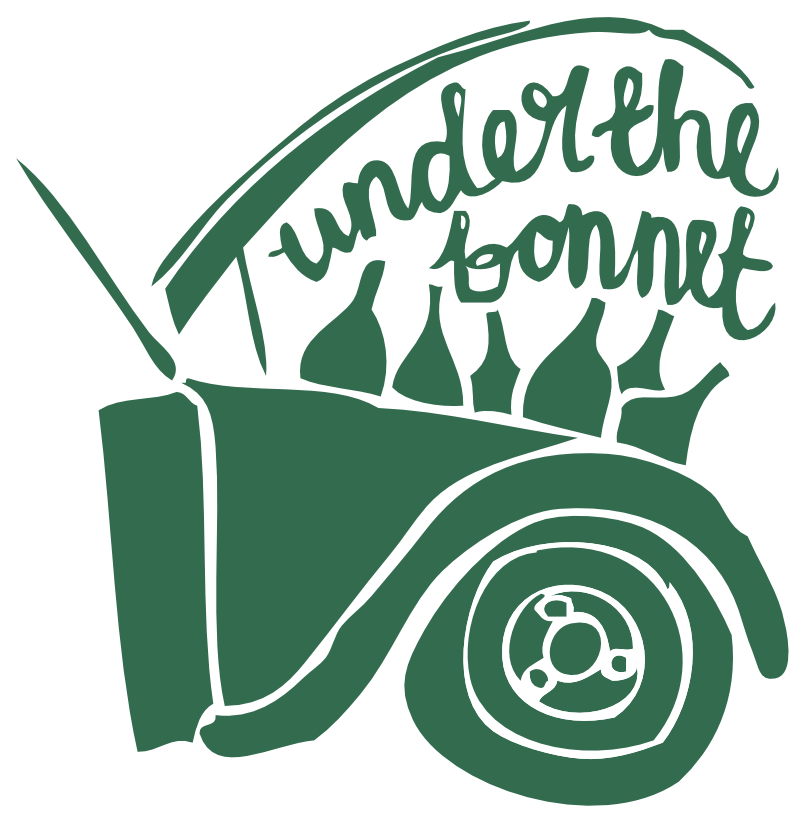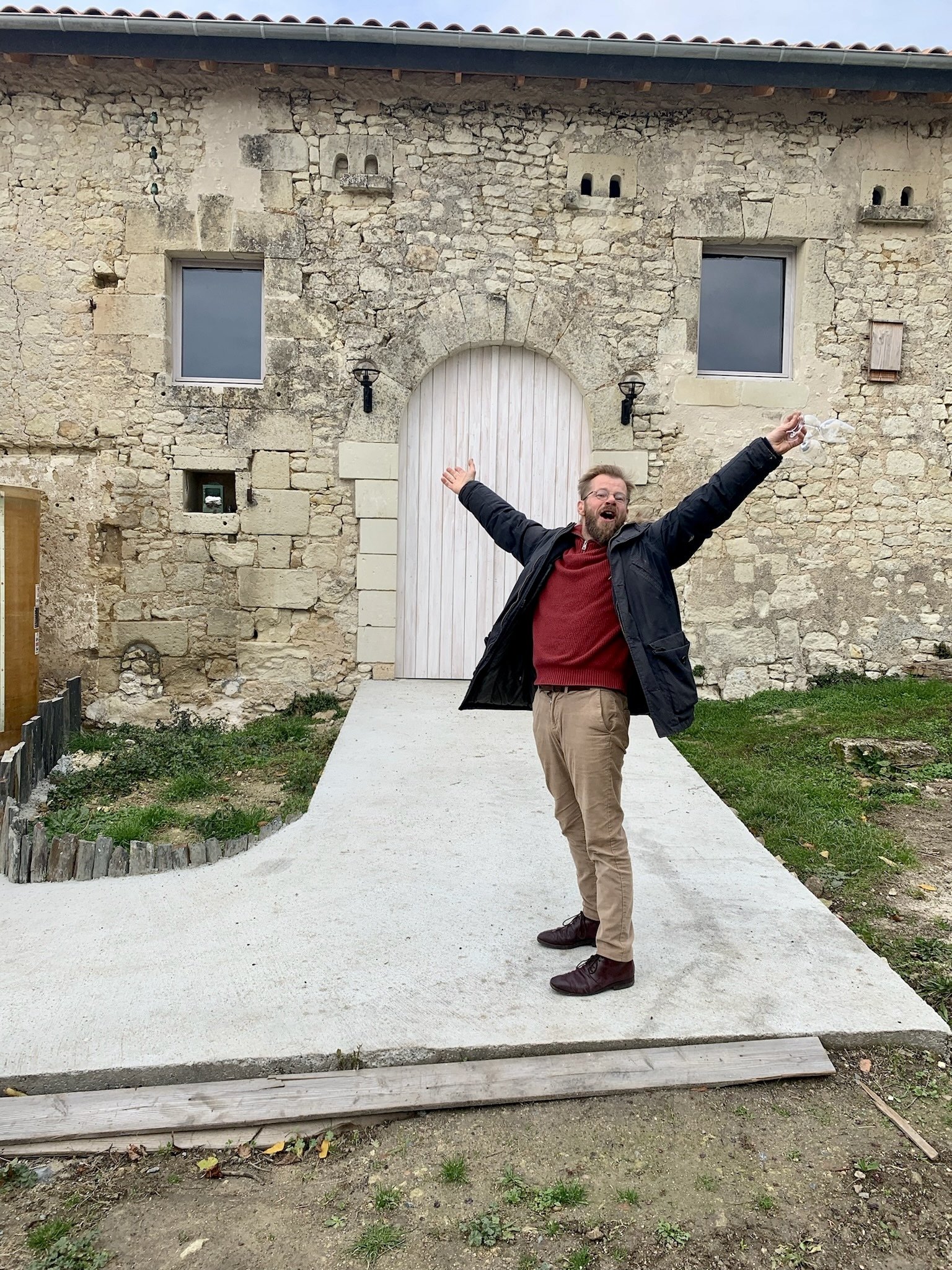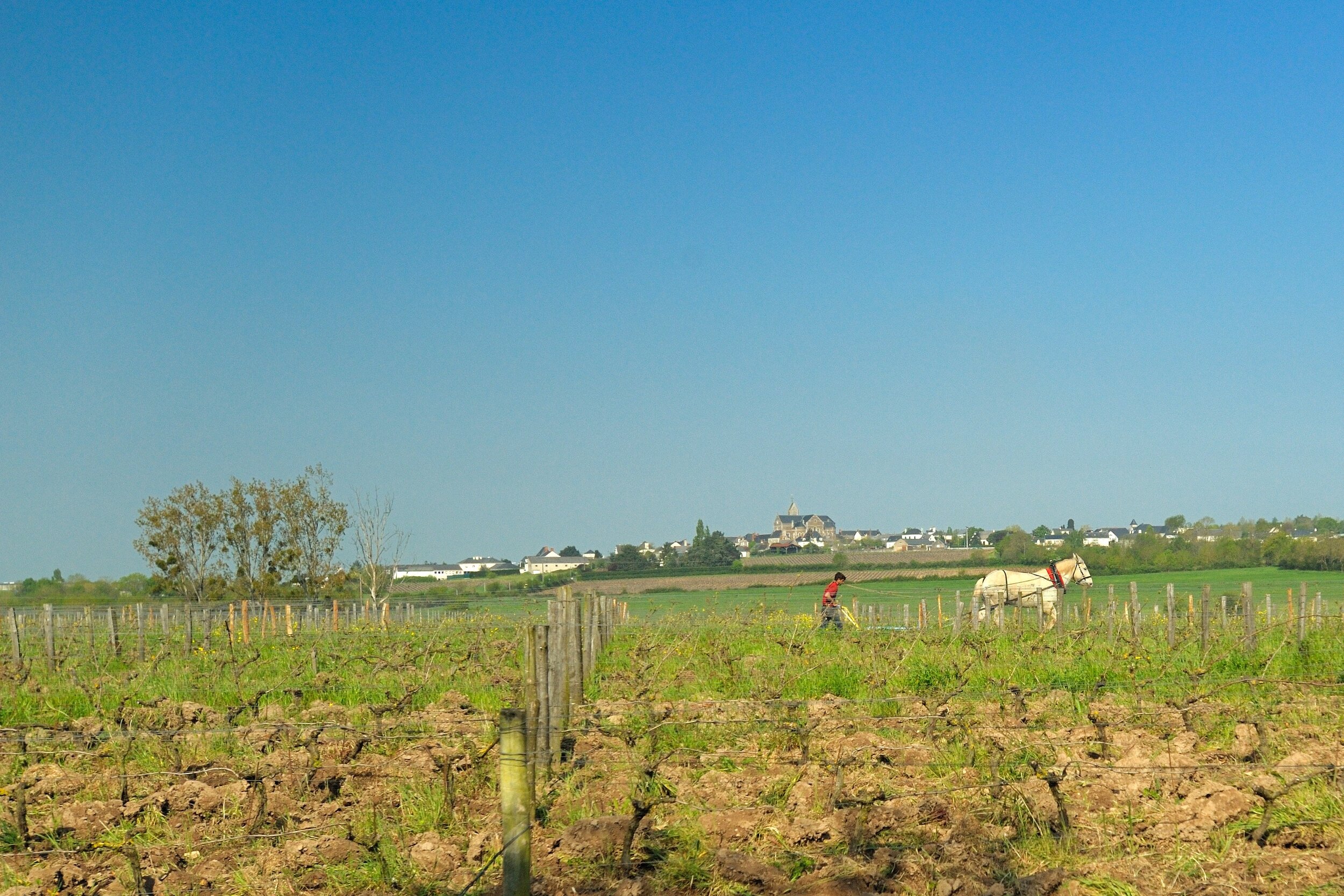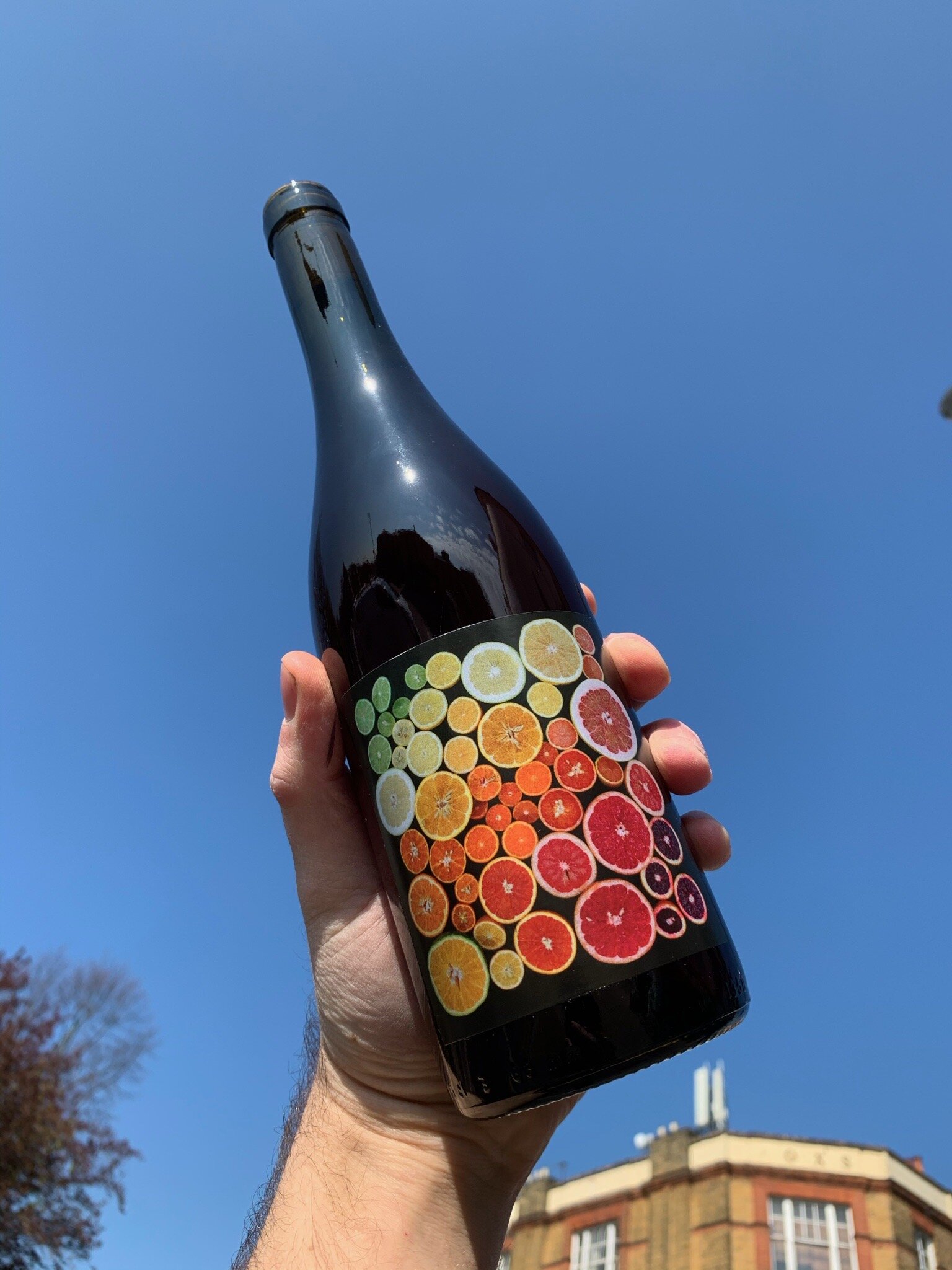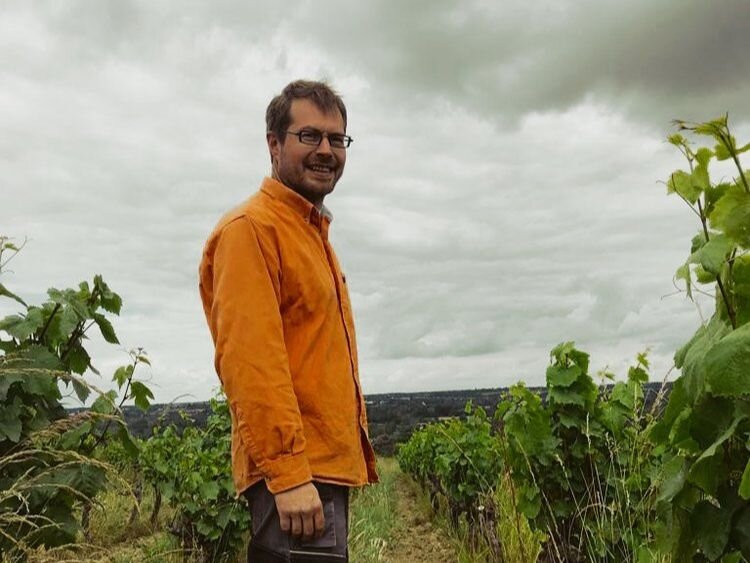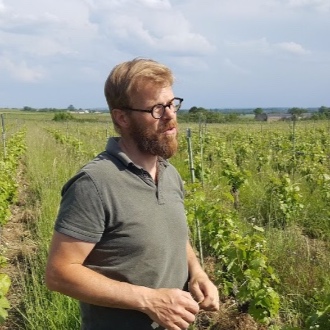For the first time in too long, we have received wines from David Foubert of La Folle Berthe. Some of the finest examples of the tuffeau-rich soils of Saumur-Puy-Notre-Dame.
Read moreWelcome to Clos Kixhaya
With their first vintage in 2020 a huge success, we're honoured to be joining Beatriz and Étienne at the start of their journey. Principled and hugely enthusiastic in their approach, they are testament to the diversity of options available with just 4 hectares of Cab Franc in Chinon, if your passion can match theirs.
Read moreComplemen'Terre: Three Years from the Muscadet Mosaic
We pleased to have new arrivals from Marion and Manu at Complemen'Terre, responsible for some of our favourite expressions of the mosaic-soils of Muscadet within just a 500m radius. We spoke with Manu recently about the new arrivals…
Read moreGrapefruit from Granite
Rémi Sédès
France, Nantes, Coteaux d’Ancenis
When we spoke with Rémi in January, he was excited to soon be bottling his 2020 Samplemousse, confirming it was tasting 'tres,tres,tres,tres,tres bon'.
2020 had gone- in contrast to the rest of the world- very smoothly in Ancenis. Yeast populations were healthy, fermentations had been fast, and the wines were tasting excellent.
Whilst 2021 started off with great promise, nature had a different plan. Over a series of consecutive sub-zero nights last week, Remi battled to save what he could of the nascent vintage. It's too early for Remi to tell how bad the damage is, whether a second bud break will be viable, but he's already looking at 50% losses.
Even if he's able to retain half of the buds, things look to be difficult for the rest of the season. The stresses of a major frost to the vine can compromise the amino acids in the juice, leading to fermentation issues and potentially increasing the risk of mousiness compromising the final wine.
Whether or not we'll see a Samplemousse next year then is to be determined, so we'll be enjoying this one all the more whilst it lasts!
Remi's grapefruit driven rosé is pressed from Gamay grown on micro-granite, yielding that aromatic, pithy citrus. Remi's work with the rosé is as delicate as possible to retain the signature aromatics. It shows.
Now In Stock
ROSE
NEW - 2020 - VDF - Samplemousse - Gamay
"The Samplemousse rosé is a direct pressing of whole bunches at a cold temperature (5-6°c) to keep the freshness of the grapes, the juiciness, and to avoid oxidation of the aromas. The fresher the juice the less oxygen dissolves into the wine. The pressing is gentle and long (about 2 to 3 hours) the juice is moved to tank by gravity to avoid pumping and damaging the aromas.
Fermentation starts naturally but gently since the juice has a temperature of 6°c. This helps express each characteristic of the indigenous yeasts, different populations start working as the wine reaches another temperature through fermentation. The wine finishes its alcoholic and malolactic fermentation, and is slowly decanted to clear itself.
Taking advantage of the cold winter, I bottled at the end of February, keeping the gas from the fermentation to retain freshness and those delicate fermentation aromas.
That's how it happened, the simplest way in the world!"
RED
2018 - Coteaux d’Ancenis -Cuvée Noé- Gamay
2018 - Coteaux d’Ancenis -Trait Gamay- Gamay
A Conversation with Pauline Mourrain
L’Austral - Pauline Mourrain & Laurent Troubat
France, Loire, Saumur Puy-Notre-Dame
Pauline Mourrain & Laurent Troubat have a few vintages under their belt now, having bottled their first as L’Austral in 2016. Following travels in Australia on different farms, and a winery on the south west coast, Pauline studied oenology in Burgundy before finishing her diploma at Domaine Melaric in Saumur Puy-Notre-Dame.
Whilst under the wing of Aymeric & Melanie, Pauline was introduced to the biodynamic pioneer Philippe Gourdon, due to retire and looking for young vignerons to lease his plots to, keeping young blood moving through the region. Philippe had campaigned hard in the 90’s to defend the Puy-Notre-Dame appellation, and despite retiring from winemaking, has remained an active and involved member of their community.
We’ve just received a top up of releases from L’Austral, so caught up with Pauline this week to talk about their new caves, adapting vinifications to climate and the joys of not having to sleep in the winery next harvest.
You sent some pictures of you guys lowering amphora into a cave, is that a new space you’ve moved to recently?
Yes very recent! We just moved from our old winery, to a new cellar dug into the Tuffeau here. It's just 5 minutes from our old one, but we’ve moved house too so we can live above the cellar.
Now we have caves, which we didn't really have before, they're so nice. They're going to be really useful. For fermentations they'll be perfect, everything will be in here. Our old winery did have some caves but they were too deep, the fermentations were always stop and start, it was so difficult for us.
We had been looking for more vines so we started buying a bit of grapes, but with the new plot that we now own, we have enough- we won't need to be buying any more.
We have 6.5 hectares now, which is perfect for us, it means we can be in the vines, we can look after the vinification. We do this job to be in the vines, we don't want to just be managers. Maybe it will be different when we are 50!
The new plot has been organic for 15 years, we've got Grolleau, Cab Franc, Chenin, Grolleau Gris- which we’ll use to make some white bubbles. It's nice, we have more varieties now. All between 4 to 80 years old, lots of variation, all on Tuffeau. They're all next to Aymeric & Melanie's vines at Melaric.
We’ve got a top up of wines from 2017 & 2019 arriving, how were those vintages for you?
For us, 2019 was a bit between '17 and '18. '17 was a classic Loire vintage, and ‘18 was very hot; lots of rain in spring and very hot in summer, so we had grapes that were really ripe, really black fruit in the wines. 2017 we didn't have much rain in the spring, which can lead to tannins feeling harsher when the wine is young, so we had to wait to harvest, it wasn't perfect yet. 18 was very much the opposite, no tannins!
So 2019 was very elegant, like a classic Loire valley wine, but with mature grapes, the fruit is soft at first with really great structure and acidity. 2019 for me, was a very, very nice vintage, I love the 19's, they're really elegant.
2020 though, was too hot. We picked very early, in the first week of September. When we started, in 2016 we picked our first block on the 5th of October. It's changed a lot.
When Philippe Gourdon used to work these plots he was always de-stemming everything. But with the climate change since we started, he suggested we have a go at doing whole-bunch because the grapes get so mature now. Philippe’s fruit was so much more vegetal, and this was the style too. With everything changing, we have to adapt to keep freshness and fruit.
2017 - AOC Saumur Le Puy-Notre-Dame - Manta
We worked with the plot Phillippe used to call 253 in 2016, but from 2017 changed the vilification and started to make Manta. These are 20 year old vines grown on our ‘tuffeau’ - chalk.
It's a 50/50 mix of destemmed and whole bunch in the tank, in layers. It's a technique we picked up at Les Foulards Rouge in Roussillon, they were doing it with their Carignan & Syrah, and we loved the wine so much, we decided to try it in 17. It really worked, and we've made it the same way every year since.
We don't extract a lot, it's more like an infusion, we just make sure to keep the cap wet. It has 15 days before pressing and then it ages in tank. It's juicy, easy drinking but not simple, it has complexity.
2019 - AOC Saumur - Octopus Rouge
When we moved to the new winery and house, it came with two hectares. In 2019 we really wanted to buy the place, but were a bit unsure we could do it, so we bought just the fruit that year, though it's our block now. That’s what we made Octopus with.
It's a 50/50 blend between 30 year old Grolleau and Cab Franc. Grolleau was fermented whole bunch in one tank, the Cab Franc was pressed directly into another.
That's another trick we learned in the Roussillon, something Jean-Philippe Padié showed us he was doing to preserve freshness. We really like this wine, perfect for spring and summer, the spice in the Grolleau really comes through.
2019 - VDF - Jolie Brise Rosé
This was made with fruit purchased just 2 minutes from us here, from a friend called Thibault Masse, in the second year of organic conversion.
It’s 100% Cab Franc on Tuffeau also. 50% of the Cab Franc was pressed directly, and the other half had about a 3 day maceration to help with structure. It began fermentation in tank, finished in bottle and left about 3g of residual sugar. It’s just lovely, juicy pet nat, the 19 was really good.
There’s such a strong community among the growers in Puy-Notre-Dame, how does that translate into the day to day?
There is a lot of helping each other, we're all very close, it's easy to work together. We’re never alone, we see Aymeric every day almost! We share the tractor, we share the harvest. We're very happy here. There's no competition, everyone is here to help one another, we share customers, share knowledge.
If people drink a lot of wine from Saumur Puy-Notre-Dame they'll discover how special a region it is. Aymeric is very passionate about that, he really pushes the movement for discovering our location.
Working with Aymeric & Melanie was a real revelation, I learned so much from them, it was just fascinating. I finished my diploma in 2015, and we did our first vintage as L'Austral in 2016. Aymeric said Philippe was stopping, and thought we’d want to take some of the vines. We're not from families with vineyards so we had to jump at the opportunity!
Laurent didn't do a diploma, he just learnt on the job, in the vines. There's so much help round here for us.
Françoise and Philippe, and then Aymeric & Melanie have been so encouraging of the younger generation, do you feel like you & Laurent will be passing that torch on too?
We're trying to do the same, to keep that spark!
With our new plot, we could have 11 hectares of vines, but we decided instead to rent a few hectares to two new young winemakers, Charlotte & Fred. They also interned with Aymeric.
It's important to have new people here, it's vital for the collective community. It's a real movement from Aymeric. Phillippe believed so much in the Puy-Notre-Dame terroir, he generated so much momentum at the beginning that it's all of our work now to keep that spirit going.
With your new location, do you have any plans for the future you’ll be able to start getting in place now?
The important thing for us is that in our new caves the temperature is so perfect for the wines, for the fermentations. When you work without chemicals, the temperature is the big thing- to have stable temperatures is very important.
In the vines, there's a possibility in the future to plant some trees around the borders of our plots, to help with the temperature in the vineyards, to keep the birds, improve biodiversity. We've got two blocks without vines, and Aymeric has some horses and sheep now, they're living in those plots at the moment!
We have a lot of collective things to do around here, all of our vineyards are in the same location really so there's a lot of things to do together. I'm looking forward to getting to know our new plots, to see what works, what we'll need to improve.
Now that we have the house in the same place, it's really perfect. We were living 5-10 minutes by bike before, which isn't far, but the winery wasn't insulated and we were working a lot by night, so there was a lot of back and forth, back and forth. The first vintage we had our kid, we were sleeping in the winery during harvest!
It's a happy memory, but I'm looking forward to having our home here this time.
Now In Stock
Sparkling
2019 - VDF - Jolie Brise Rosé - Cab Franc
Red
2019 - AOC Saumur - Octopus Rouge - Grolleau/Cab Franc
2017 - AOC Saumur - Le Puy-Notre-Dame - Manta - Cab Franc
For wholesale price lists please email hello@winesutb.com
From Anjou with Love
Thomas Boutin
France, Loire, Anjou, Rochefort-sur-Loire, Angers
Now finally back in stock: 2018 Charabia, Celsiane and La Quillette. We've had a quick chat with Thomas:
"2018 has been difficult but with a good result. We've had loads of rain in June which caused mildew. It stopped in July and the heat allowed us to fight the mildew, which then resulted in a good harvest both quality and quantity wise."
"As for the 2018 cuvees, there were a couple of changes. For example for Charabia, which is normally 100% Chardonnay, I have added 15% of Chenin, to make the wine more round. For La Quillette I have upped the Grolleau percentage from 5% to 20%, to add more peppery and spicy notes. In general what happened was that my yield has generally doubled, it went from 13 hl/ha in 2017 to 30 hl/ha in 2018."
"Each wine has a name for a reason: La Quillette means 'la petite bouteille' - 'the small bottle'. This stands for a wine which is very easy to drink and quick to finish, it is overall a light and fruity wine.”
”La Charabia stands for a person who doesn't make sense when they talk: 'tu fait du Charabia' - 'you are talking nonsense'. As this is again a very easy drinking wine, so 'Charabia' is basically what happens as the end result.
Celsiane is a name of a rare tulip which grows near Coteaux du Layon, and I have chosen this name as a homage to my parents and grandparents who were all working in agriculture, same as me before I started making wines. This particular tulip is also often planted in between the vines of biologically farmed vineyards is order to help cultivate them."
"This year so far we were lucky and we haven't had any frost or mildew. It is looking rather hot already, so I'm planning to harvest around the 23rd/ 24th of August. Which means about 2 weeks earlier than last year. Let's see where this takes us!"
Now in Stock
WHITE
2018 Charabia - Chardonnay (85%), Chenin (15%)
Manual harvest. Direct pressing. Vinification with natural yeasts. Aged in vats, on the lees for 10 months. Unfiltered, racked before bottling.
2018 Celsiane - Chenin
Manual harvest. Direct pressing. Vinification with natural yeasts. Aged in vats, on the lees for 11 months. Unfiltered, racked before bottling.
RED
2018 La Quillette - Gamay (60%), Cab Franc (20%) & Grolleau (20%)
Manual harvest. Direct pressing. Vinification with natural yeasts. Whole bunch maceration for 8 days in vats. Separate maceration and vinification for all grape varieties. Aged in vats, on the lees for 9 months. Unfiltered, racked before bottling.
WHOLESALE ONLY
FOR PRICE LIST ENQUIRIES, EMAIL hello@winesutb.com
A Chat With Thomas Boutin
Thomas Boutin
France, Loire, Anjou, Rochefort-sur-Loire, Angers
Thomas Boutin started his own winemaking project in 2008, with only 1.8 hectares. In 2011, he inherited a compact winery and vines from his mentor, and has progressively built up the number of hectares. He farms two hectares in Rochefort-sur-Loire and one hectare in Saint Aubin. He is evolving as a winemaker, and experiments whilst learning and finding his style.
Having studied oenology and worked in larger wineries, he is passionate to keep the approach small-scale with minimal intervention. All wines are made without any use of chemicals, are unfined and unfiltered with little use of sulfur.
Tell us about your 2018 harvest: What were your challenges? What went particularly well?
2018 has been difficult but with a good result. We've had loads of rain in June which caused mildew. It stopped in July and the heat allowed us to fight the mildew, which then resulted in a good harvest both quality and quantity wise.
What do you anticipate for the 2019 harvest?
I always wait until September to have a better idea of the end result. August is a really important month when it comes to maturity of the wines. For the moment what I can see is that the buds are developing well from the outside, but I cannot tell yet how good the quality is.
What is your personal favourite vintage you have made to date and why?
I have two: 2012 and 2016 when it comes to quality, even though the yield was very small. I haven't made loads of money but the wines turned out amazing.
Which wines do you enjoy drinking besides your own?
Normally I enjoy drinking full-bodied wines but at the moment I drink light reds. There is no particular region that I prefer, I am more about discovering new wines, especially from outside of France.
Are there any winemakers whose influence has been particularly important?
Benoît Landron has helped me out immensely. We enjoy sharing our wines and I will always be helpful to him as he has helped me to establish myself as a winemaker.
Also, there are other winemakers who have taught me a lot and who are less into natural wines but are still organic certified. For example Benjamin Delobel. There are always more things to learn as there are always new challenges coming up.
What can you tell us about your future plans?
I want to reduce the use of copper in the vineyard. Also, I want to create a new cuvée. At first I thought about using barrels but now I feel like I am at a point where I'm more connected with the earth and I want to try making a cuvée using amphora.
Further down the road I'd like to plant Pinot d'Aunis and Grolleau Gris and have some fun experimenting making new cuvées.
Now in stock
White
NEW 2017 Celsiane - Chenin
"100% chenin, from five different plots. Two plots consist of 60-70 year old vines, planted after the second world war in mass selection. The other three are between 20-30 years old in clonal selection: one with coarse grains and normal maturity, the second one with very early coarse grains, I sometimes pick it up a week ahead of the other vines, and the last with small grains and a normal maturity. The fermentation took place over one year. This wine has a fresh mouth, very ripe fruit, almost dry fruit with hints of honey. Warm notes of plum which remind of Alsatian wines and give the wine a bit of pep."
2016 Charabia - Chardonnay
"Small yield due to frost (loss of 5 - 10%) mildew (loss of 35 - 40%)and heat. The harvest went well in the end with good maturity of the grapes. It is a well-balanced wine with notes of exotic fruit and a lot of freshness. An easy drinking Chardonnay."
Red
NEW 2017 La Quilette - Gamay (60%), Cabernet Franc (35%) & Grolleau (5%)
"Small yield due to frost, but as the rest of the year has been pretty balanced we didn't get the feared mildew. Maceration and fermentations occured separately for each grape variety. I macerated for 7-8 days with whole bunches before pressing. The tanks were assembled the following spring when fermentations were complete. Harvest started already on August 23. This was the earliest I have ever had to start as the grapes were maturing very fast due to warm weather. Compared to previous vintages, the 2017 vintage has less acidity, more structure and more notes of compote red fruits, but it's still a light wine."
Sweet
2011 Topaze - Chenin
Thomas' first harvest. Hand-harvested from three vineyard selections. Direct-press with indigenous yeasts used, three years in barrel. No filtration, racked twice to remove lees before bottling.
For any wholesale and stock enquiries, please contact hello@winesutb.com
Friends from Saumur
Mélaric / L' Austral / Folle Berthe / Château Tour Grise
Phillippe Gourdon
Saumur Puy-Notre-Dame, Loire, France
Our friends from Saumur all have something in common: They are connected through Phillippe Gourdon (Château Tour Grise) - a pioneer in biodynamic farming. After Phillippe retired they have started renting off bits of his vineyard to new, younger generation winemakers in an attempt to keep the blood flowing in Saumur. So, what's the story?
Melanie Hunin, from Paris, and Aymeric Hillaire, from Saumur, established Domaine Melaric (a weaving of their names) in 2006 at the Chateau de Baugé, near the village of Puy-Notre-Dame. In 2008, they purchased four hectares of vineyards in Saumur Puy-Notre-Dame with advice from Philippe Gourdon.
Laurent and Pauline (Domaine L'Austral) worked for one year as engineers in France but were not very happy stuck in front of a computer. They travelled and worked in Australia in different farms and in a winery on the west coast. Pauline then studied in Burgundy to become an enologist. During her first internship, Pauline worked with Melaric who introduced them to Françoise and Philippe Gourdon in Le Puy-Notre-Dame, who in turn had vines to lease.
David Foubert (Domaine Folle Berthe), formerly a Parisien journalist, moved to Saumur for a life change and to study winemaking. Aymeric and Melanie have been a key influence; Melanie was David’s teacher at winemaking school, and David’s first vintage in 2014 was made in their cellar. David moved into his own – once-abandoned but now lovingly restored – cellar in 2015. He now farms a mix of parcels leased from Philippe.
Château Tour Grise
Phillippe's eight-hectare vineyard is made up of six hectares of Cabernet Franc and one each of Chenin Blanc and Pineau D’Aunis. It has been entirely biodynamic since 1998, a crucial status for Phillippe, who wants to create wines that express a true sense of their terroir. In the vineyard life flourishes; the grass remains long and wild all summer long; the vines remain untrimmed and are treated with various special herbal tea preparations of nettles, presses and willows to keep sickness at bay.
The weather systems coming in off the Atlantic are forced upwards by the Mauges hills to the west of Anjou. This causes a rain shadow which gives Saumur more of a continental climate. Le-Puy – being practically the most southerly point – averages less than 200mm/year. The elongated growing season this allows enables the wines to achieve ripeness.
Wines now in stock
Domaine Mélaric
NEW 2016 Billes de Roches - Chenin
Some serious Chenin, soft balanced use of oak. Lean and tense.
NEW 2011 Liquoreux de la Cerisaie - Chenin
Powerful, intense and deep with a spicy, savoury edge to the concentrated raisin and marmalade flavours. Incredible concentration and notes of straw, herb and syrup.
Domaine Folle Berthe
2016 Petit Berthe - Pineau d'Aunis
Bright, showing just a touch of development. Slightly more body than Pineau d'Aunis from more northerly vineyards, still with characteristic redcurrant fruit and a white pepper finish.
Domaine L' Austral
NEW 2017 Manta - Cab Franc
Whole grape vatting. Alcoholic fermentation in indigenous yeasts, nine-month ageing in concrete eggs.
NEW 2017 Jolie Brise Blanc - Chenin
Direct pressing, alcoholic fermentation in indigenous yeasts. Beginning of the alcoholic fermentation in the tank, finishing in the bottle.
NEW 2017 Jolie Brise Rosé - Cab Franc
Direct pressing for half of the grapes and short maceration (about three hours) for the other half. This is what gives the intense colour and structure in the mouth. Alcoholic fermentation in indigenous yeasts, beginning of the alcoholic fermentation in vats, finishing in the bottle.
2016 - Cuvee 253 - Cab Franc
Planted in 2002-03. Manual harvest, Destemmed. Maceration for 60 days – infusion only, indigenous yeasts, aged nine months in concrete eggs.
For wholesale prices, please email hello@winesutb.com
